The Effect of Steel and Basalt Fibers on the Shear Behavior of Double-Span Fiber Reinforced Concrete Beams
Abstract
:1. Introduction
- Matrix fracture and matrix spalling (or fragmentation);
- Fiber-matrix interface debonding;
- Post-debonding friction between fiber and matrix (fibre pull-out);
- Fiber fracture;
- Fiber abrasion and ductile deformation (or yielding) of fibre.
- The effect of different fiber materials (steel or basalt fiber) on shear cracking behavior.
- The contribution of steel or basalt fibers to shear resistance, ductility, and changes in the failure mode of reinforced concrete beams.
2. Materials and Methods
2.1. Materials
2.2. Experimental Program
- Series C-III—without stirrups (Figure 3d).
3. Test Results and Discussion
3.1. The Effect of Fibers on Capacity
3.2. The Effect on Deflection
3.3. Development of Cracks and Failure Modes of Beams
3.4. The Influence of Fibers on Shear Stress
3.5. Effect of Fibers on Deformation
4. Capacity Calculations Using RILEM and Fib-MC2010 Recommendations
4.1. Calculations of Shear Capacity Pursuant to RILEM TC 162—TDF (2003)
4.2. Calculation of Shear Capacity Pursuant to fib Model Code 2010
4.3. Comparison of Results
5. Conclusions
- The shear capacity of double-span beams L = 4.15 m increased in beams made of concrete with steel or basalt fibers.
- The shear stresses at the center support were greater compared to the volume of stresses at the extreme supports. The volume of shear stress depends on the degree of shear reinforcement (the greater the degree of shear reinforcement, the greater the value of shear stresses). The presence of fiber reinforcement in the concrete also increased shear stresses.
- Beams in all series made of concrete with steel or basalt fibers were characterized by lower deflections compared to reference beams at the same load level. Due to the use of steel fibers in concrete, the values of deflection in all series of beams were three times smaller, while in the case of concrete with basalt fibers in C-III-WB5 beams, they were twice as small compared to beams made of concrete without fibers.
- Change in the angle of diagonal cracking indicates that the addition of steel or basalt fibers changes the failure mode of reinforced concrete beams from shear (brittle) to less brittle (shear tension failure) with higher displacements at failure.
- Digital Image Correlation (DIC) analysis of the crack pattern around the central support confirmed the influence of both types of fibers on the crack pattern and shear behavior of beams with reduced reinforcement for shear.
- The shear capacity of SFRC (steel fiber-reinforced concrete) beams tested in this study, consistent with literature data, were estimated using fib-MC2010 and RILEM guidelines. RILEM guidelines resulted in closer predictions of test results. The fib-MC2010 recommendations gave a more conservative estimate of the capacities than RILEM provisions.
- In times of rising steel prices they are sought to replace it. The test results confirm the possibility of complete or partial replacement of steel stirrups by concrete with basalt fibers.
Author Contributions
Funding
Institutional Review Board Statement
Informed Consent Statement
Data Availability Statement
Conflicts of Interest
References
- Santos, P.; Laranja, G.; França, P.M.; Correia, J.R. Ductility and moment redistribution capacity of multi-span T-section concrete beams reinforced with GFRP bars. Constr. Build. Mater. 2013, 49, 949–961. [Google Scholar] [CrossRef]
- Arslan, G.; Keskin, R.S.O.; Ulusoy, S. An Experimental Study on the Shear Strength of SFRC Beams without Stirrups. J. Theor. Appl. Mech. 2017, 55, 1205–1217. Available online: http://yadda.icm.edu.pl/baztech/element/bwmeta1.element.baztech-9477c382-1df2-44bb-8a13-102199f6cf80 (accessed on 4 April 2019). [CrossRef] [Green Version]
- Patel, V.R.; Darji, N.S.; Pandya, D.I.I. Experimental Study of Cracking Behaviour for SFRC Beams without Stirrups with Varying A/D Ratio. Int. J. Eng. Res. Dev. 2012, 1, 1–5. [Google Scholar]
- Barragán, B.E. Failure and Toughness of Steel Fiber Reinforced Concrete under Tension and Shear. Ph.D. Thesis, Universitat Politècnica de Catalunya, Escola Tècnica Superior d’Enginyers de Camins, Canals i Ports de Barcelona, Barcelona, Spain, 2002. Available online: http://www.tdx.cat/handle/10803/5905 (accessed on 11 May 2021).
- Parra-Motesions, G.J. Shear Strength of Beams with Deformed Steel Fibers. Concr. Int. 2006, 28, 57–66. [Google Scholar]
- Robert, M.; Cousin, P.; Benmokrane, B. Durability of GFRP Reinforcing Bars Embedded in Moist Concrete. J. Compos. Constr. 2009, 13, 66–73. [Google Scholar] [CrossRef] [Green Version]
- Dinh, H.H.; Parra-Montesinos, G.J.; Wight, J.K. Shear Behavior of Steel Fiber-Reinforced Concrete Beams without Stirrup Reinforcement. Struct. J. 2010, 107, 597–606. [Google Scholar] [CrossRef]
- Cucchiara, C.; La Mendola, L.; Papia, M. Effectiveness of stirrups and steel fibres as shear reinforcement. Cem. Concr. Compos. 2004, 26, 777–786. [Google Scholar] [CrossRef]
- Kosior-Kazberuk, M.; Krassowska, J. Fracture Behaviour of Basalt and Steel Fibre Reinforced Concrete. Bud. I Inżynieria Sr. 2015, 6. Available online: http://yadda.icm.edu.pl/baztech/element/bwmeta1.element.baztech-c24d6461-4ca9-4293-822b-77d10b36092a (accessed on 4 April 2019).
- Abed, F.; Alhafiz, A.R. Effect of basalt fibers on the flexural behavior of concrete beams reinforced with BFRP bars. Compos. Struct. 2019, 215, 23–34. [Google Scholar] [CrossRef]
- Lakavath, C.; Joshi, S.S.; Prakash, S.S. Investigation of the effect of steel fibers on the shear crack-opening and crack-slip behavior of prestressed concrete beams using digital image correlation. Eng. Struct. 2019, 193, 28–42. [Google Scholar] [CrossRef]
- Tur, V.; Kosior-Kazberuk, M.; Grygo, R.; Tur, A.; Krassowska, J. Concrete Structures; Politechnika Białostocka: Białystok, Poland, 2020. [Google Scholar] [CrossRef]
- Löfgren, I. Fibre-reinforced Concrete for Industrial Construction—A Fracture Mechanics Approach to Material Testing and Structural Analysis; Chalmers University of Technology: Göteborg, Sweden, 2005. [Google Scholar]
- Cook, J.; Gordon, J.E. A mechanism for the control of crack propagation in all brittle systems. Proc. R. Soc. London. Ser. A. Math. Phys. Sci. 1964, 282, 508–520. [Google Scholar]
- Gopalaratnam, V.; Shah, S.P. Softening response of plain concrete in direct tension. ACI Mater. J. 1985, 82, 310–323. [Google Scholar]
- Barragán, B.E.; Gettu, R.; Martín, M.A.; Zerbino, R.L. Uniaxial tension test for steel fibre reinforced concrete—A parametric study. Cem. Concr. Compos. 2003, 25, 767–777. [Google Scholar] [CrossRef]
- Hillerborg, A.; Modéer, M.; Petersson, P.-E. Analysis of crack formation and crack growth in concrete by means of fracture mechanics and finite elements. Cem. Concr. Res. 1976, 6, 773–781. [Google Scholar] [CrossRef]
- Swamy, R.N.; Barr, B. Fibre Reinforced Cement and Concretes: Recent Developments; Division of Structural Engineering Faculty of Engineering, LTH Lunds University; CRC Press: Boca Raton, FL, USA, 1989. [Google Scholar]
- Althin, A.; Lippe, M. Size Effects in Shear Force Design of Concrete Beams; LTH Lunds University: London, UK, 2018. [Google Scholar]
- Ramesh, B.; Eswari, S. Mechanical behaviour of basalt fibre reinforced concrete: An experimental study. Mater. Today Proc. 2021, 43, 2317–2322. [Google Scholar] [CrossRef]
- Abushanab, A.; Alnahhal, W. Performance of Basalt Fiber Reinforced Continuous Beams with Basalt FRP Bars. IOP Conf. Ser. Mater. Sci. Eng. 2020, 910, 012004. [Google Scholar] [CrossRef]
- Sadrmomtazi, A.; Tahmouresi, B.; Saradar, A. Effects of silica fume on mechanical strength and microstructure of basalt fiber reinforced cementitious composites (BFRCC). Constr. Build. Mater. 2018, 162, 321–333. [Google Scholar] [CrossRef]
- Balant, P.; Kazemi, M.T. Size Effect on Diagonal Shear Failure of Beams without Stirrups. ACI Struct. J. 1991, 88, 268–276. [Google Scholar]
- Minelli, F.; Plizzari, G.A. On the Effectiveness of Steel Fibers as Shear Reinforcement. Struct. J. 2013, 110, 379–390. [Google Scholar] [CrossRef]
- Picazo, A.; Gálvez, J.C.; Alberti, M.G.; Enfedaque, A. Assessment of the shear behaviour of polyolefin fibre reinforced concrete and verification by means of digital image correlation. Constr. Build. Mater. 2018, 181, 565–578. [Google Scholar] [CrossRef]
- Funari, M.F.; Verre, S. The Effectiveness of the DIC as a Measurement System in SRG Shear Strengthened Reinforced Concrete Beams. Crystals 2021, 11, 265. [Google Scholar] [CrossRef]
- Pohoryles, D.A.; Melo, J.; Rossetto, T.; Fabian, M.; McCague, C.; Stavrianaki, K.; Lishman, B.; Sargeant, B. Use of DIC and AE for Monitoring Effective Strain and Debonding in FRP and FRCM-Retrofitted RC Beams. J. Compos. Constr. 2017, 21, 04016057. [Google Scholar] [CrossRef]
- EN 12390-3:2009—Testing Hardened Concrete—Part 3: Compressive Strength of Test Specimens. Available online: https://standards.iteh.ai/catalog/standards/cen/d1d94876-958b-4941-ade0-780076fc330a/en-12390-3-2009 (accessed on 20 April 2021).
- EN 12390-5:2019—Testing Hardened Concrete—Part 5: Flexural Strength of Test Specimens. Available online: https://standards.iteh.ai/catalog/standards/cen/5653c2c7-55a9-4bcb-8e13-5b1dfb0e3baf/en-12390-5-2019 (accessed on 20 April 2021).
- EN 12390-13:2013—Testing Hardened Concrete. Determination of Secant Modulus of Elasticity in Compression. Available online: https://shop.bsigroup.com/ProductDetail/?pid=000000000030398745 (accessed on 20 April 2021).
- EN 1992-2:2005—Eurocode 2. Design of Concrete Structures. Concrete Bridges. Design and Detailing Rules. Available online: https://shop.bsigroup.com/en/ProductDetail/?pid=000000000030187350 (accessed on 6 July 2021).
- Fédération Internationale Du Béton, Fib Model Code for Concrete Structures 2010. 2013. Available online: http://site.ebrary.com/id/10780745 (accessed on 14 March 2021).
- Vandewalle, L.; Nemegeer, D.; Balazs, L.; Barr, B.; Barros, J.; Bartos, P.; Banthia, N.; Criswell, M.; Denarie, E.; di Prisco, M.; et al. RILEM TC 162—TDF Test and Design Methods for Steel Fibre Reinforced Concrete. Mater. Struct. 2003, 36, 560–567. [Google Scholar]

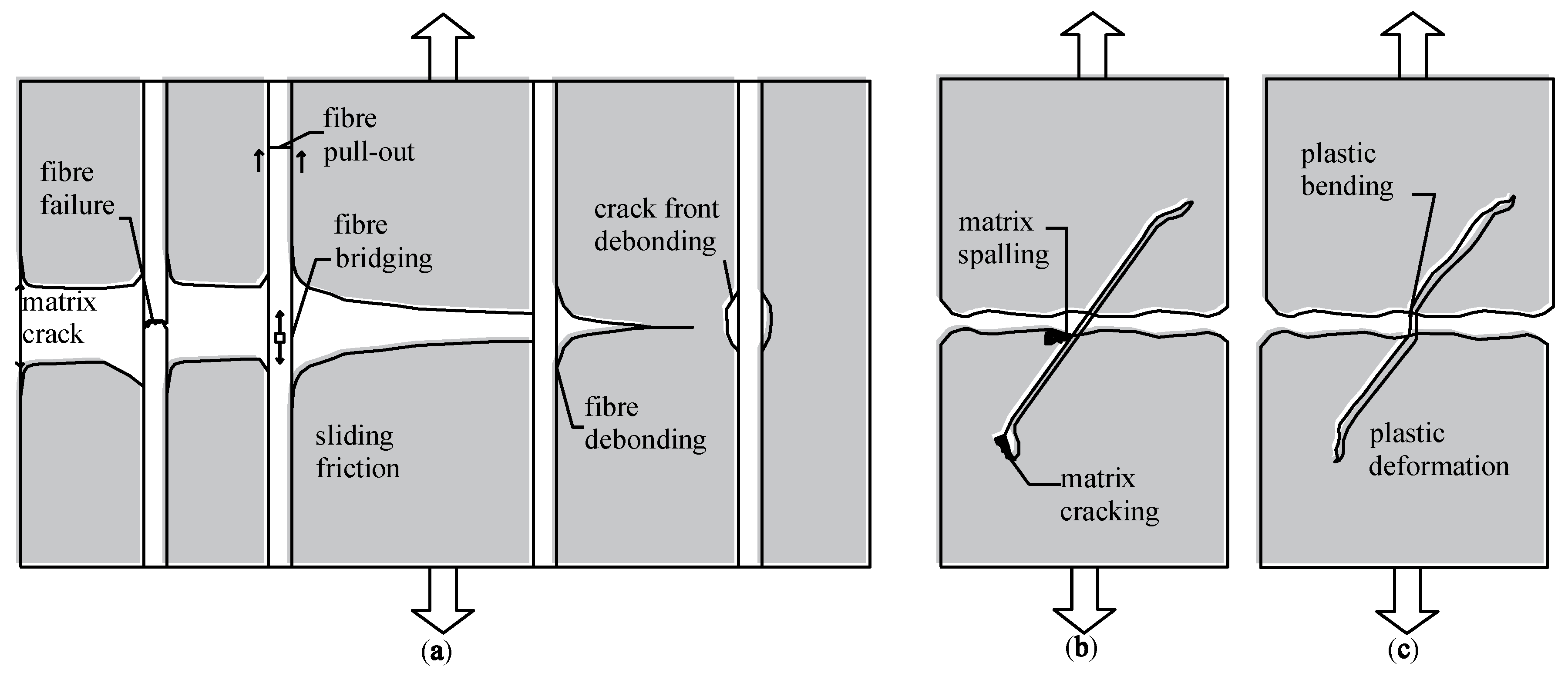
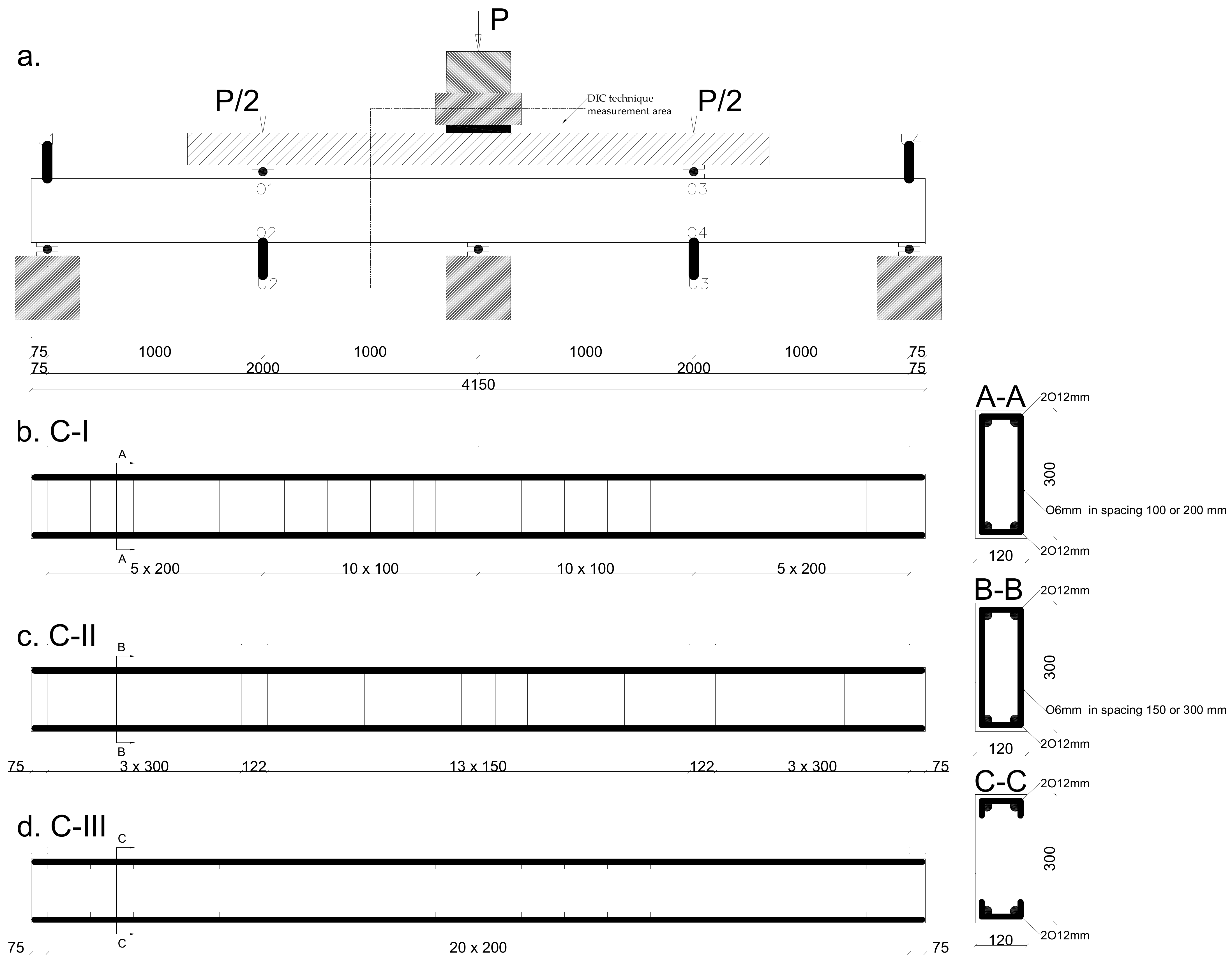
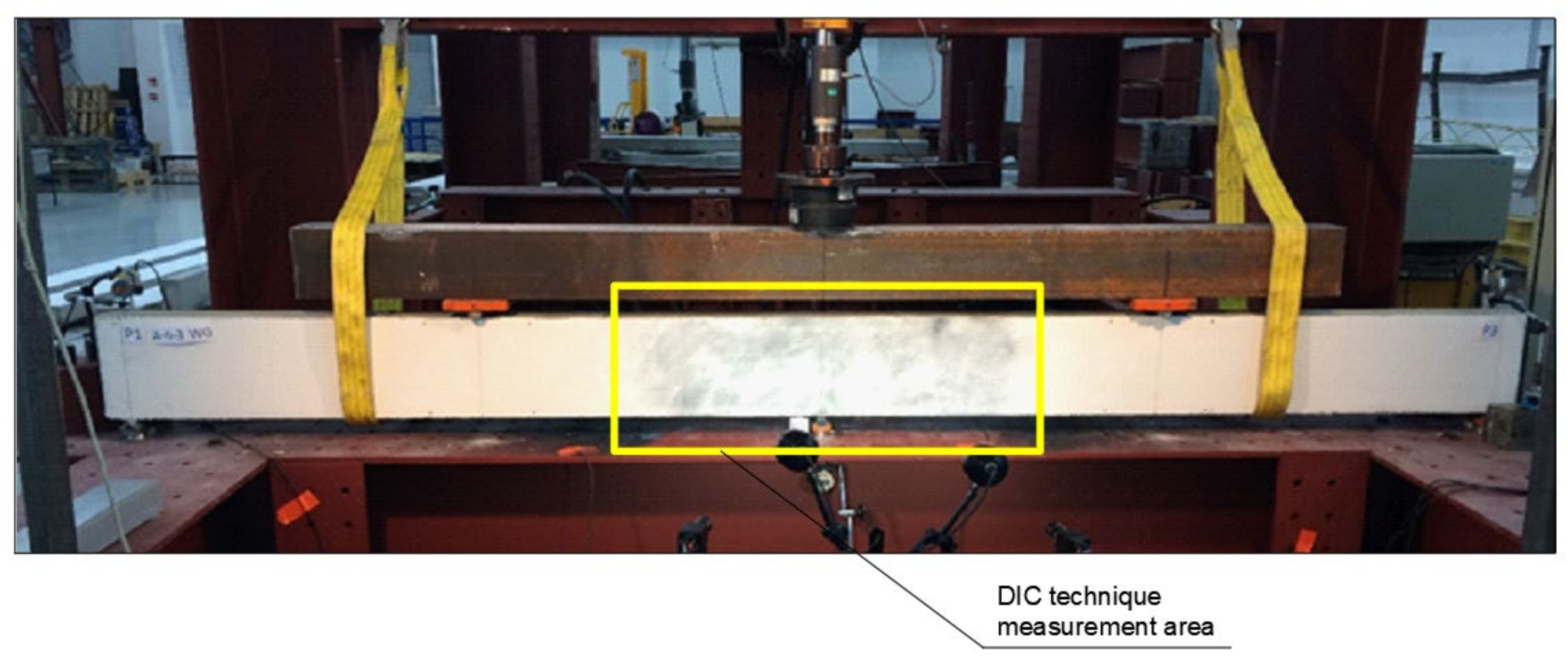
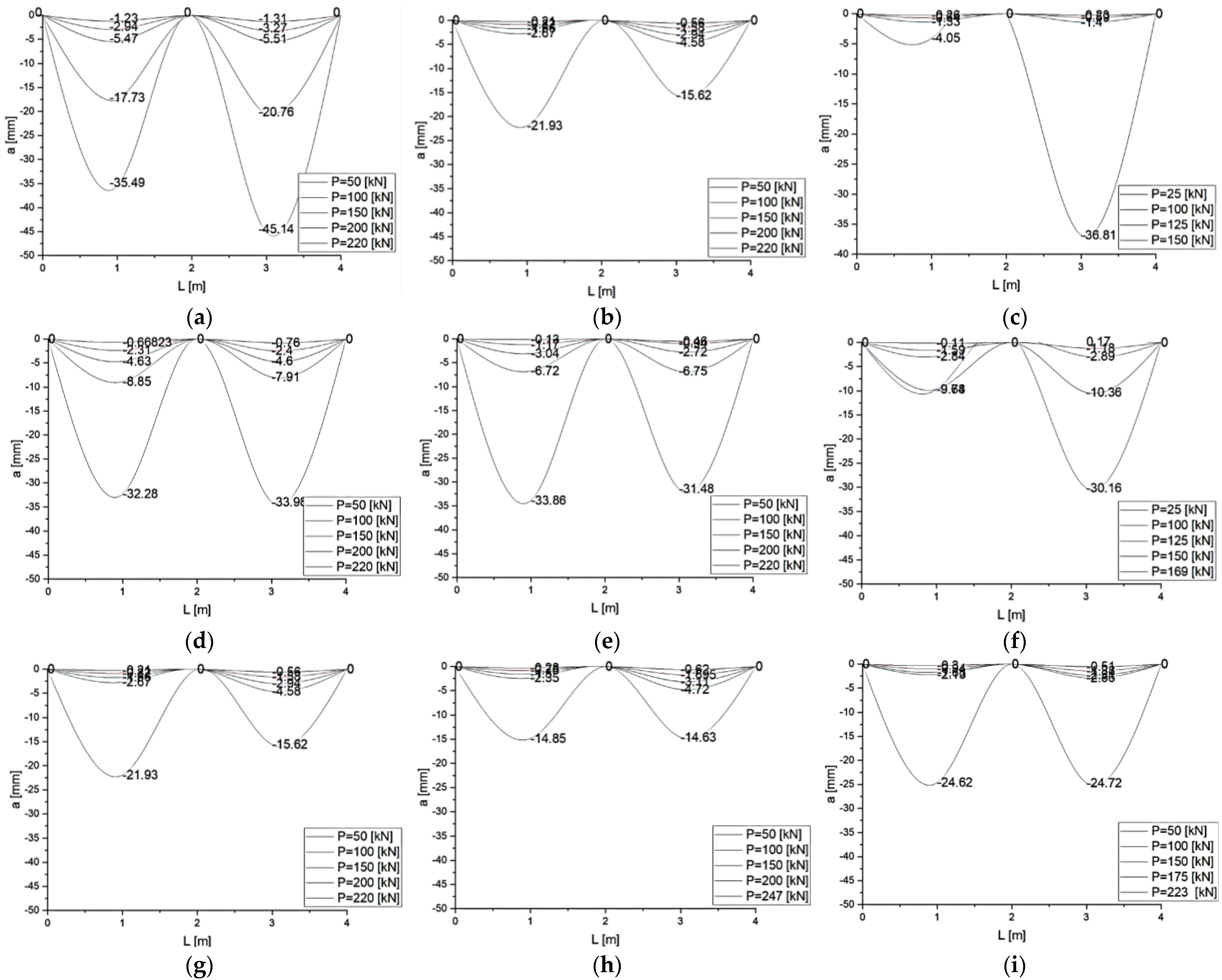
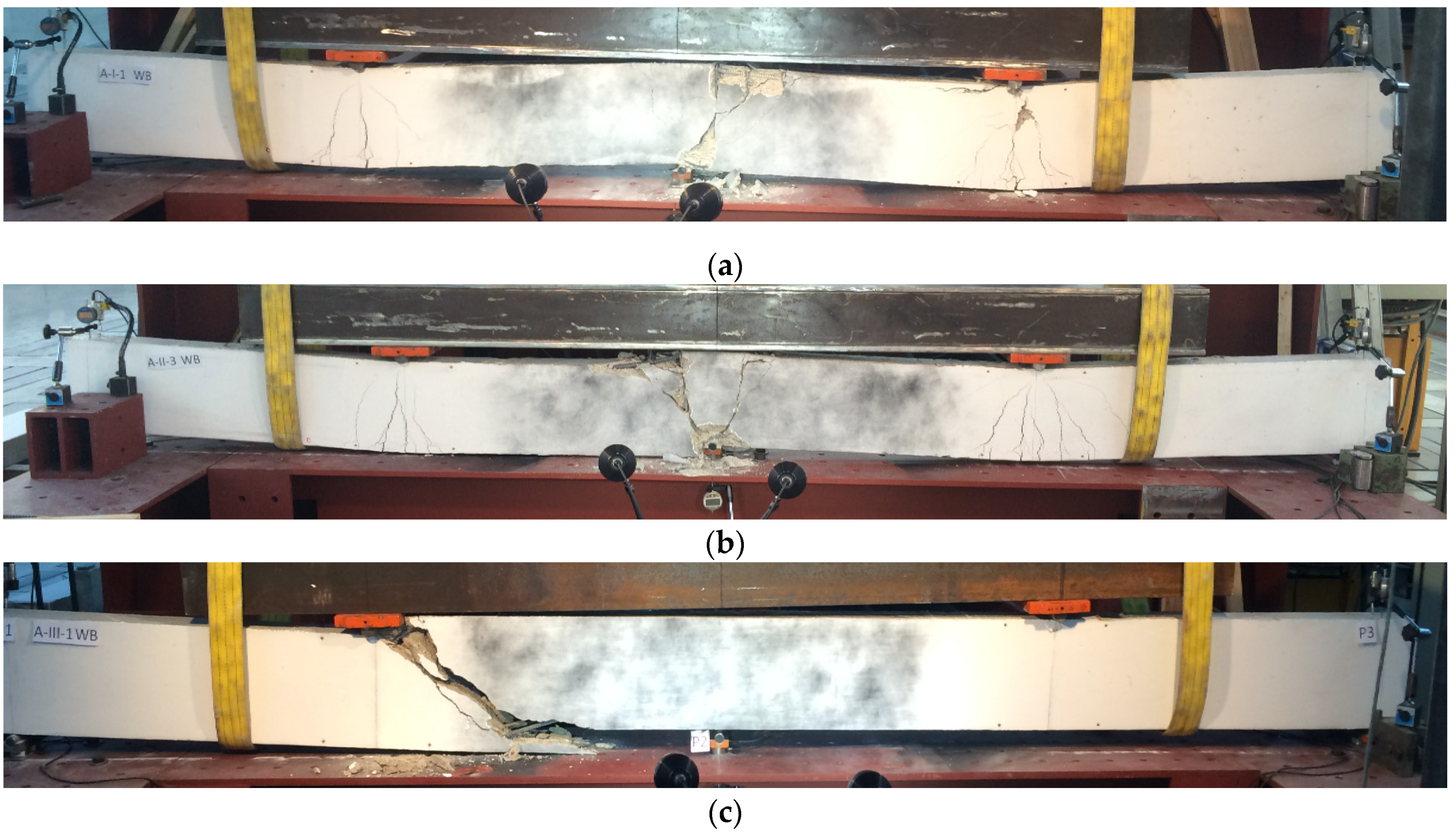
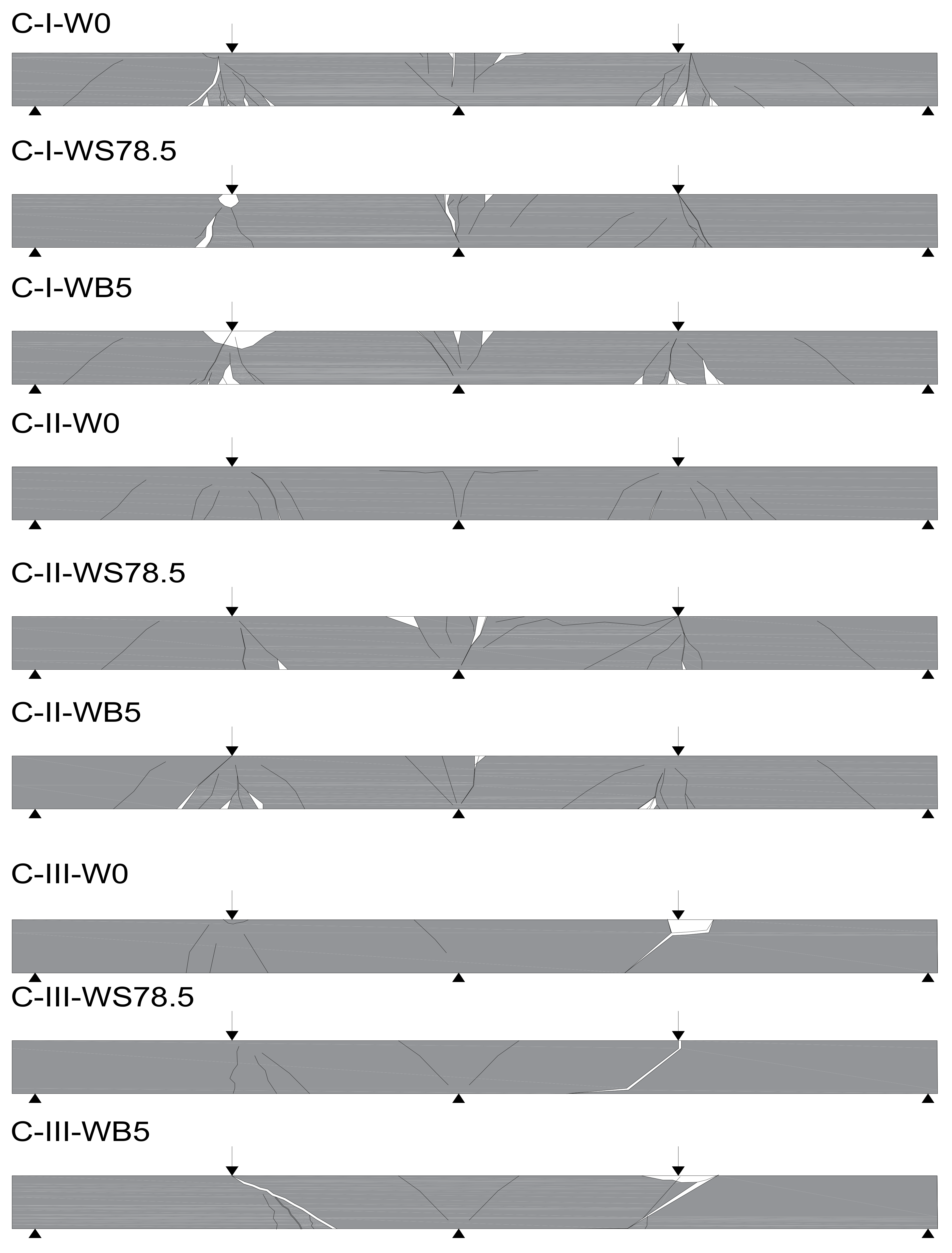
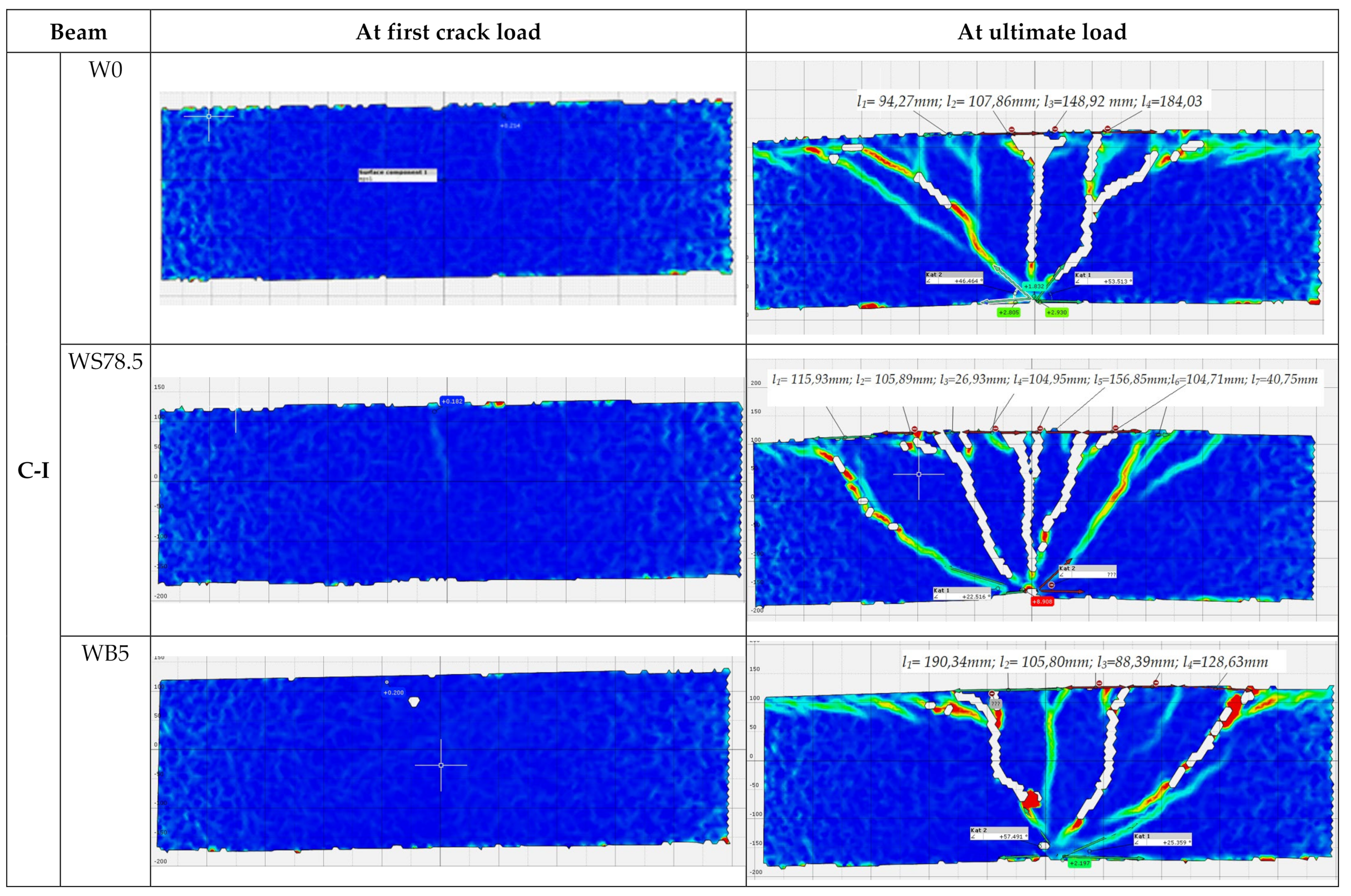
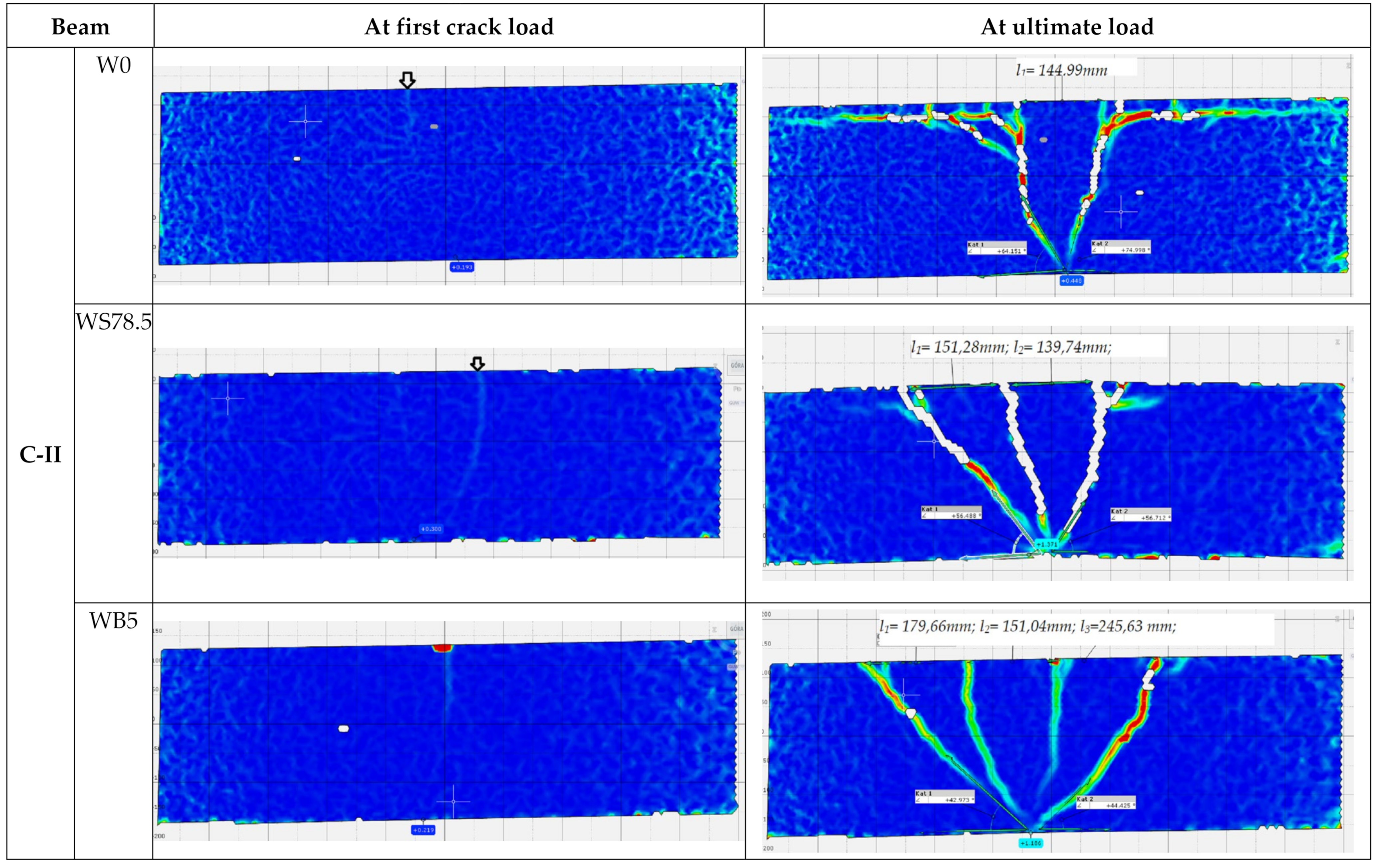
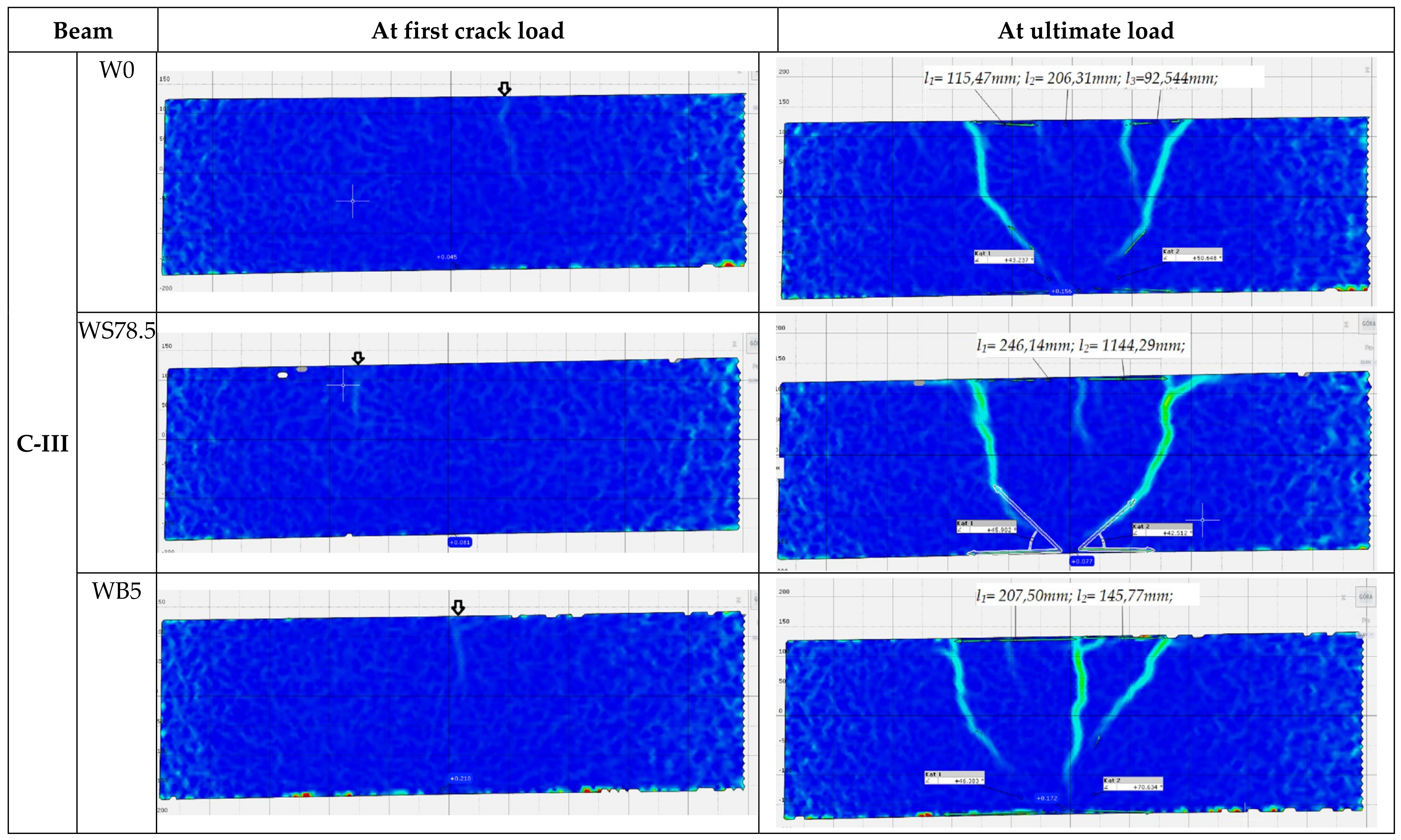



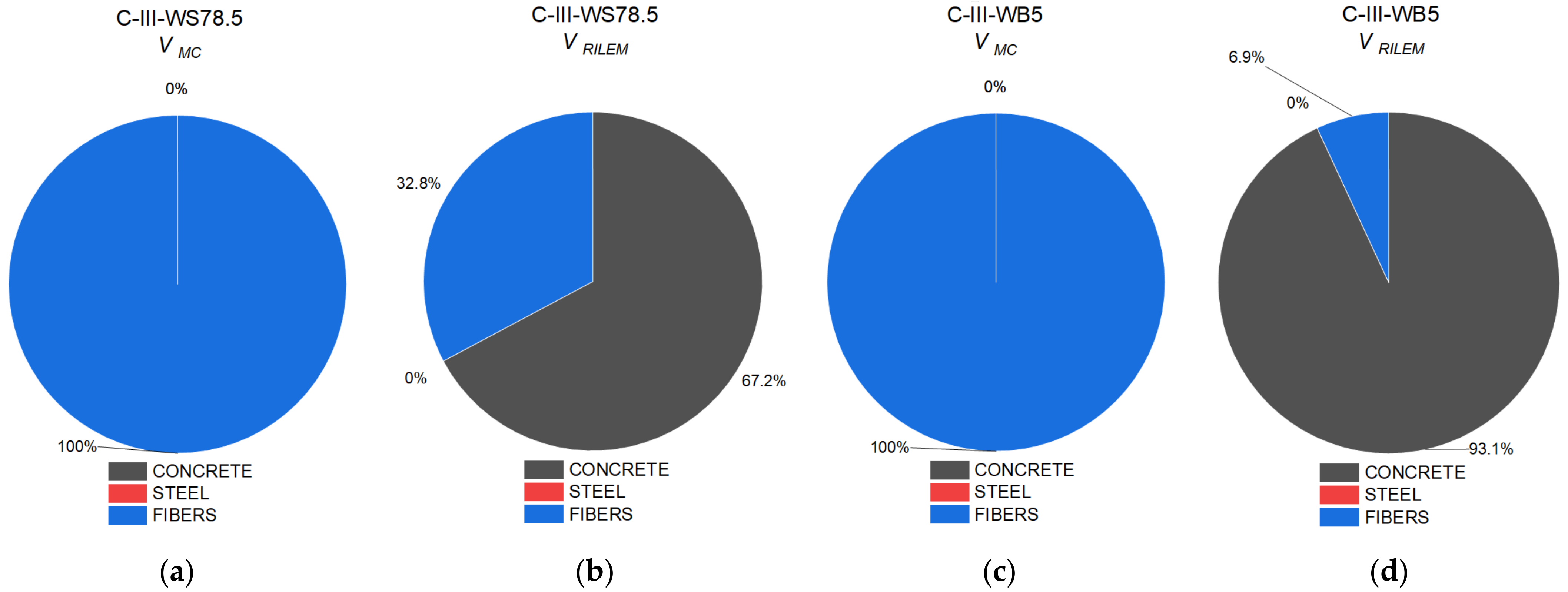
| Fiber Content | fck | fctm | Ecm | |
|---|---|---|---|---|
| [kg/m3] | [MPa] | [MPa] | [GPa] | |
| W0 | 0 | 35.19 (±0.86) | 5.14 (±0.33) | 33.29 (±1.28) |
| WS78.5 | 78.5 | 39.12 (±4.11) | 7.21 (±1.06) | 33.71 (±0.34) |
| WB5 | 5 | 29.08 (±2.94) | 6.72 (±1.22) | 32.86 (±2.33) |
| Beam | Max. Load (kN) | Mid-Span Deflection (mm) | 1st Crack Load (kN) | 1st Diagonal Crack Load (kN) | Number of Diagonal Cracks (-) | Width of Diagonal Crack (mm) | Angel of Diagonal Crack (°) | Failure Mode (-) | |
|---|---|---|---|---|---|---|---|---|---|
| W0 | 222 | 8.09 | 76.7 | 118.3 | 4 | 1.6 | 43.0 | Flexural | |
| C-I | WS78.5 | 258 | 3.61 | 86.7 | 220.0 | 1 | 1.1 | 44.7 | Flexural |
| WB5 | 229 | 8.44 | 90.0 | 160.0 | 3 | 1.9 | 40.3 | Flexural | |
| W0 | 193 | 8.68 | 66.7 | 96.7 | 1 | 0.7 | 43.0 | Shear | |
| C-II | WS78.5 | 252 | 3.04 | 80.0 | 146.7 | 3 | 1.4 | 40.7 | Flexural |
| WB5 | 228 | 4.54 | 83.3 | 136.3 | 2 | 1.4 | 44.7 | Shear | |
| W0 | 109 | 5.18 | 73.3 | 88.3 | 2 | 30.2 | 42.0 | Shear | |
| C-III | WS78.5 | 204 | 3.82 | 83.3 | 123.3 | 2 | 23.7 | 33.3 | Shear |
| WB5 | 134 | 3.13 | 86.7 | 91.7 | 2 | 28.5 | 29.0 | Shear | |
| Beam | Vcr | Vult | Vult/Vcr | |
|---|---|---|---|---|
| C-I | W0 | 42.4 | 78.5 | 1.9 |
| WS78.5 | 69.45 | 97.55 | 1.4 | |
| WB5 | 40.95 | 80.45 | 2.0 | |
| C-II | W0 | 21 | 47.95 | 2.3 |
| WS78.5 | 32.15 | 56.05 | 1.7 | |
| WB5 | 39.25 | 57.95 | 1.5 | |
| C-III | W0 | 30.75 | 36.85 | 1.2 |
| WS78.5 | 27.25 | 41.85 | 1.5 | |
| WB5 | 30.95 | 48.7 | 1.6 | |
| Beam | Vexp | VMC | VRILEM | |||||||
|---|---|---|---|---|---|---|---|---|---|---|
| VRd,c | VRd,F | VRd,s | VRd | VRd | ||||||
| C-I | W0 | 76.3 | 17.27 | 0 | 70.8 | 88.1 | 36.3 | 70.8 | 0 | 107.1 |
| WS78.5 | 88.6 | 0 | 76.88 | 70.8 | 129.72 | 36.3 | 70.8 | 17.68 | 124.78 | |
| WB5 | 78.7 | 0 | 22.3 | 70.8 | 93.1 | 36.3 | 70.8 | 2.7 | 109.8 | |
| C-II | W0 | 70 | 19.55 | 0 | 47.2 | 66.75 | 36.3 | 47.2 | 0 | 83.5 |
| WS78.5 | 86.6 | 59.23 | 47.2 | 106.43 | 106.43 | 36.3 | 47.2 | 17.68 | 101.18 | |
| WB5 | 78.3 | 0 | 22.3 | 47.2 | 69.5 | 36.3 | 47.2 | 2.7 | 86.2 | |
| C-III | W0 | 37.4 | 30.38 | 0 | 0 | 30.38 | 36.3 | 0 | 0 | 36.3 |
| WS78.5 | 70.1 | 0 | 0 | 0 | 62.53 | 36.3 | 0 | 17.68 | 53.98 | |
| WB5 | 46 | 0 | 0 | 0 | 3.7 | 36.3 | 0 | 2.7 | 39.0 | |
Publisher’s Note: MDPI stays neutral with regard to jurisdictional claims in published maps and institutional affiliations. |
© 2021 by the authors. Licensee MDPI, Basel, Switzerland. This article is an open access article distributed under the terms and conditions of the Creative Commons Attribution (CC BY) license (https://creativecommons.org/licenses/by/4.0/).
Share and Cite
Krassowska, J.; Kosior-Kazberuk, M. The Effect of Steel and Basalt Fibers on the Shear Behavior of Double-Span Fiber Reinforced Concrete Beams. Materials 2021, 14, 6090. https://doi.org/10.3390/ma14206090
Krassowska J, Kosior-Kazberuk M. The Effect of Steel and Basalt Fibers on the Shear Behavior of Double-Span Fiber Reinforced Concrete Beams. Materials. 2021; 14(20):6090. https://doi.org/10.3390/ma14206090
Chicago/Turabian StyleKrassowska, Julita, and Marta Kosior-Kazberuk. 2021. "The Effect of Steel and Basalt Fibers on the Shear Behavior of Double-Span Fiber Reinforced Concrete Beams" Materials 14, no. 20: 6090. https://doi.org/10.3390/ma14206090
APA StyleKrassowska, J., & Kosior-Kazberuk, M. (2021). The Effect of Steel and Basalt Fibers on the Shear Behavior of Double-Span Fiber Reinforced Concrete Beams. Materials, 14(20), 6090. https://doi.org/10.3390/ma14206090






